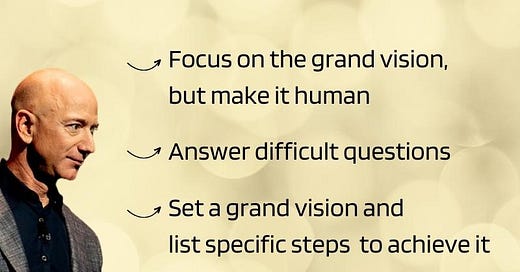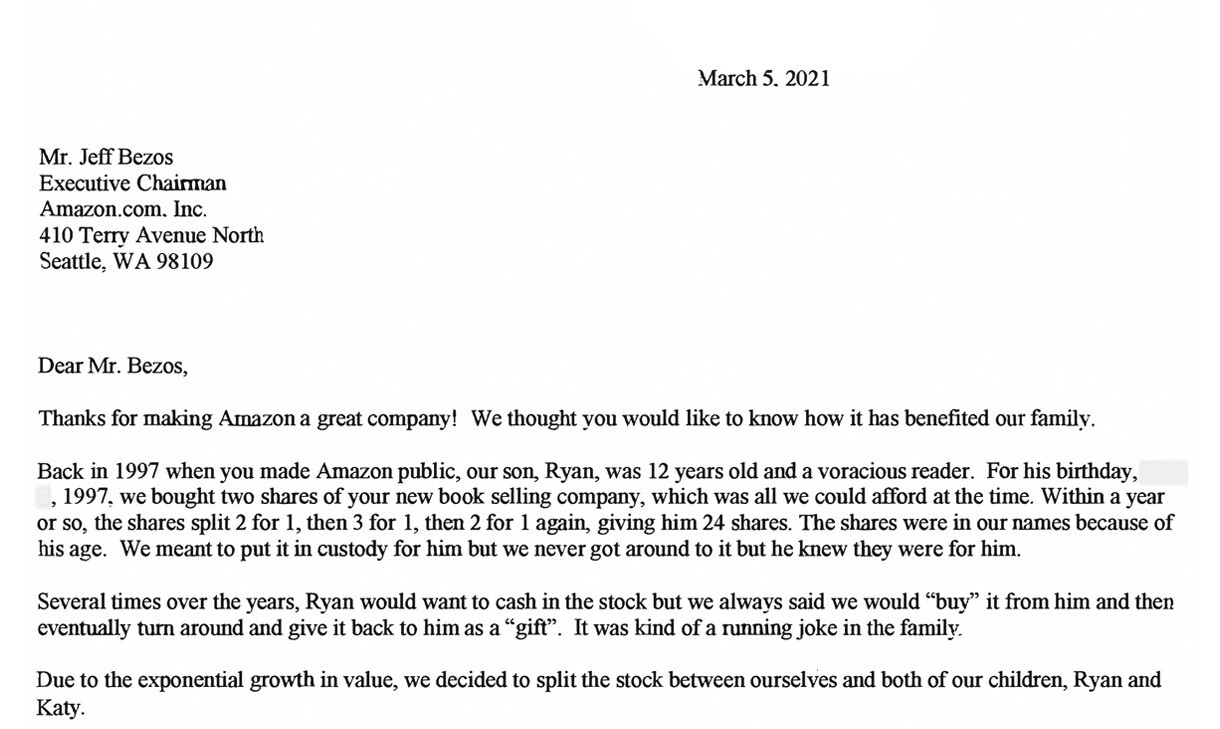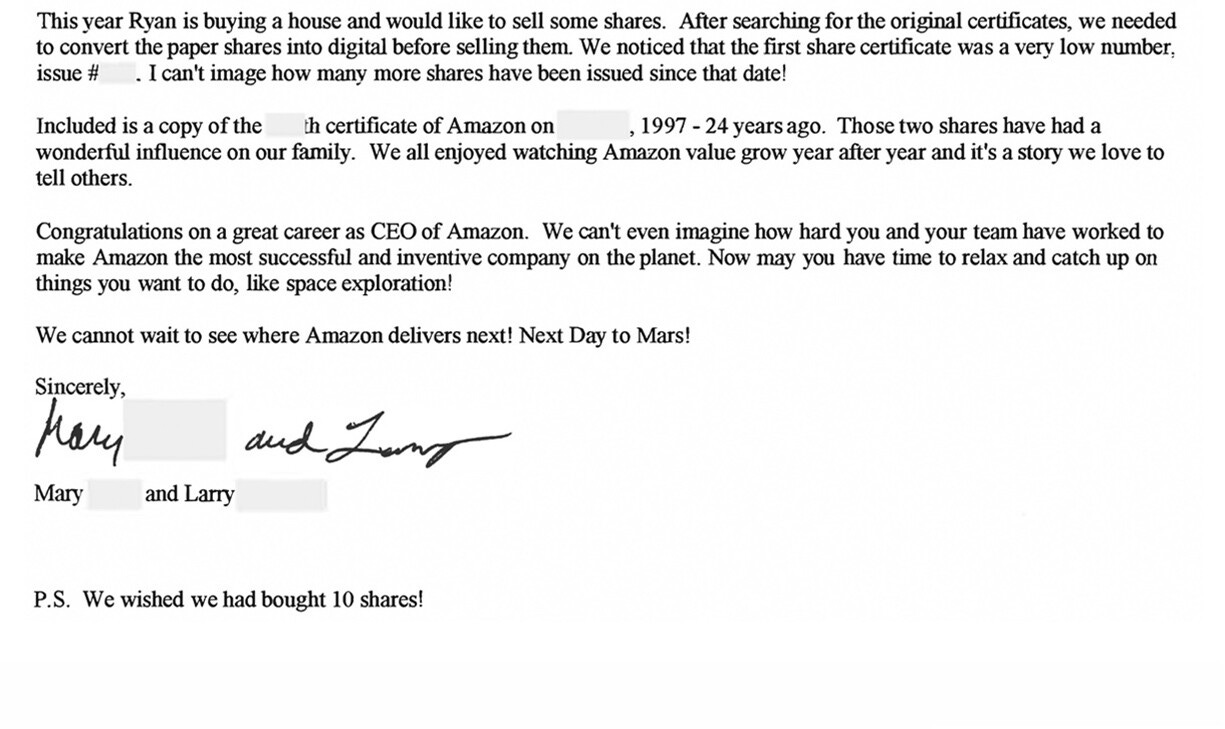Takeaways from Jeff Bezos's Letter to Shareholders
Set grand vision, develop specific tactics, measure and iterate - and fight for your distinctiveness
Tell me in a sentence
Set grand vision, develop specific tactics, measure and iterate - and fight for your distinctiveness
Tell me in an image
Tell me more
I publish my newsletter weekly. Bezos publishes his yearly. His is filled with gems, and mine is, well, I will let you be the judge of that. Let us take a look at what we can learn from one of the most successful entrepreneurs of our time - through his annual letters to shareholders.
Focus on the grand vision, but make it human
Bezos starts his 2020 letter with a napkin math calculation of the value that Amazon created - 300 Billion. And then he attaches a personal letter from a couple about how 2 Amazon shares from 1997 affected their family - positively.
While 300B sounds impressive, the letter is far more effective in imprinting the value that Amazon created on the reader.
Be comfortable with ambiguity
Bezos is very comfortable with napkin math. He cares about the accuracy of the calculation but is not stuck due to the absence of precision. Take a minute and think about how you would answer the following questions.
How much time does online shopping save a typical individual?
How would you value an individual’s time?
Customers complete 28% of purchases on Amazon in three minutes or less, and half of all purchases are finished in less than 15 minutes. Compare that to the typical shopping trip to a physical store – driving, parking, searching store aisles, waiting in the checkout line, finding your car, and driving home. Research suggests the typical physical store trip takes about an hour. If you assume that a typical Amazon purchase takes 15 minutes and that it saves you a couple of trips to a physical store a week, that’s more than 75 hours a year saved. That’s important. We’re all busy in the early 21st century. So that we can get a dollar figure, let’s value the time savings at $10 per hour, which is conservative. Seventy-five hours multiplied by $10 an hour and subtracting the cost of Prime gives you value creation for each Prime member of about $630. We have 200 million Prime members, for a total in 2020 of $126 billion of value creation.”
I have seen well-meaning professionals1 getting stuck because they are uncomfortable making assumptions. This stops them from answering the business question. We should follow Bezos’s lead and focus on being ‘roughly right than precisely wrong’2.
Answer difficult questions
Bezos takes the concerns about how warehouse and delivery employees are treated head-on. He jots down specific examples of how Amazon is working towards the grand vision of being Earth’s Best Employer.
“We dive deep into safety issues. For example, about 40% of work-related injuries at Amazon are related to musculoskeletal disorders (MSDs), things like sprains or strains that can be caused by repetitive motions. MSDs are common in the type of work that we do and are more likely to occur during an employee’s first six months. We need to invent solutions to reduce MSDs for new employees, many of whom might be working in a physical role for the first time.
One such program is WorkingWell – which we launched to 859,000 employees at 350 sites across North America and Europe in 2020 – where we coach small groups of employees on body mechanics, proactive wellness, and safety. In addition to reducing workplace injuries, these concepts have a positive impact on regular day-to-day activities outside work….
Our increased attention to early MSD prevention is already achieving results. From 2019 to 2020, overall MSDs decreased by 32%, and MSDs resulting in time away from work decreased by more than half.”
Notice how Bezos answers a difficult question with the grand vision of being earth’s best employer. He goes on to identify safety as a key initiative to achieving that status, brings up the WorkingWell program, and then quantifies the accomplishments of the program. Impressive right?
This transitions well to the next one.
Set a grand vision and list specific steps to achieve it
Bezos is talking about climate change and The Climate Pledge
“Transportation is a major component of Amazon’s business operations and the toughest part of our plan to meet net-zero carbon by 2040...A big reason we want companies to join The Climate Pledge is to signal to the marketplace that businesses should start inventing and developing new technologies that signatories need to make good on the Pledge. Our purchase of 100,000 Rivian electric vans is a perfect example.
To further accelerate investment in new technologies needed to build a zero-carbon economy, we introduced the Climate Pledge Fund last June. The investment program started with $2 billion to invest in visionary companies that aim to facilitate the transition to a low-carbon economy. Amazon has already announced investments in CarbonCure Technologies, Pachama, Redwood Materials, Rivian, Turntide Technologies, ZeroAvia, and Infinium”
Same framework as we saw last time
Grand vision - fight climate change
Specific initiative - Climate Pledge, Climate Pledge Fund
Accomplishments - Ordered 100,000 electric vans, $2 billion fund, list of companies that the fund invested in
Bezos kept the best for the last
Fight for your distinctiveness
“We all know that distinctiveness – originality – is valuable. We are all taught to “be yourself.” What I’m really asking you to
do is to embrace and be realistic about how much energy it takes to maintain that distinctiveness. The world wants you to be typical – in a thousand ways, it pulls at you. Don’t let it happen.
You have to pay a price for your distinctiveness, and it’s worth it. The fairy tale version of “be yourself” is that all the pain stops as soon as you allow your distinctiveness to shine. That version is misleading. Being yourself is worth it, but don’t expect it to be easy or free. You’ll have to put energy into it continuously.”
Think about all the things that make you different and special. What is the common theme around the professional compliments that you receive? Maybe it is that
you can see the big picture or
you bring energy and enthusiasm to the table or
you are humble and easy to work with or
you always focus on what is good for the customer or
you can prioritize well or
you are comfortable with ambiguity
Now what do you do when
you get pulled into the weeds or
most of the team is not enthusiastic about the project or
your peers and higher-ups boss you around or
your customer is stubborn and rude or
some projects get de-prioritized and fall behind schedule or
decisions that you made in the past appear to be not-so-sound?
It is easy to fall into the trap of normal and strip yourselves of your unique magic. Fight for it. Bezos says it is worth it!3
Harry Styles ended his SNL session4 by encouraging us to ‘treat people with kindness’5. Let me leave you with the same. Treat people with kindness - now that would be a good way to distinguish yourselves!
Even data analysts… Gasp!
John Maynard Keynes's quote
One of my professors used to say ‘blend in, but stand out’. Same, but different!
The link is to the opening monologue. I could not find the closing one
I was very surprised to hear that as the closing message from a very popular artist






